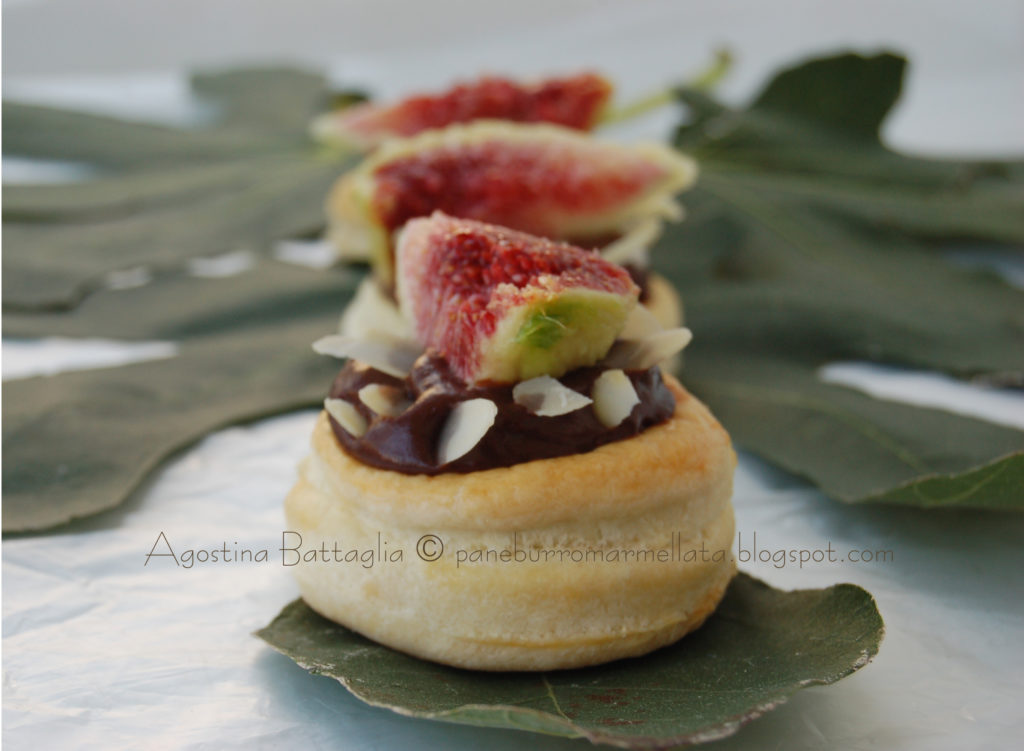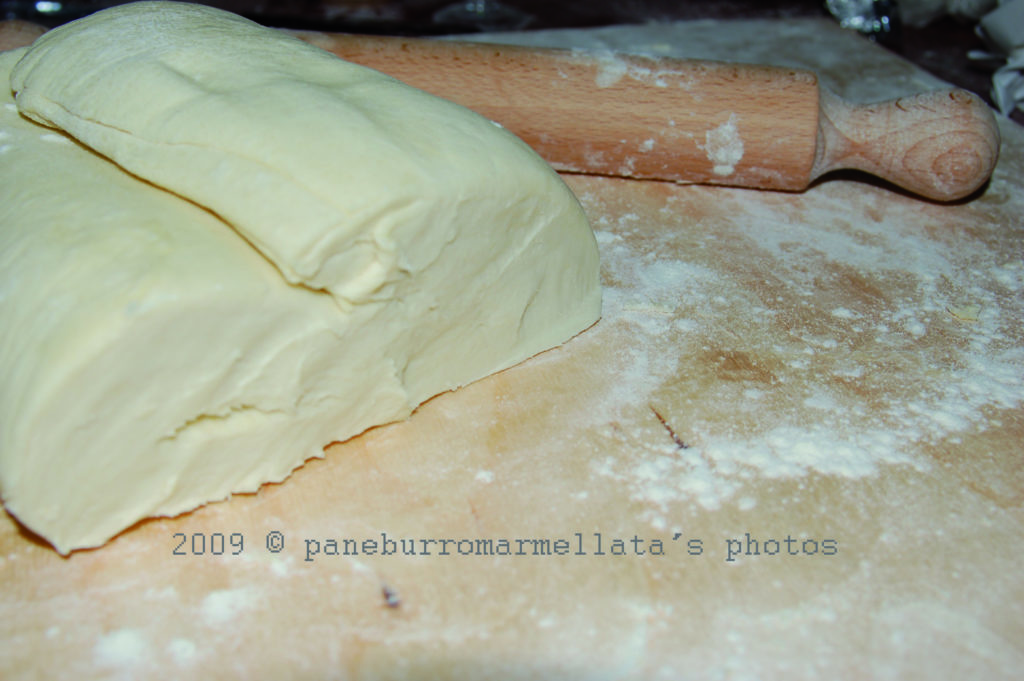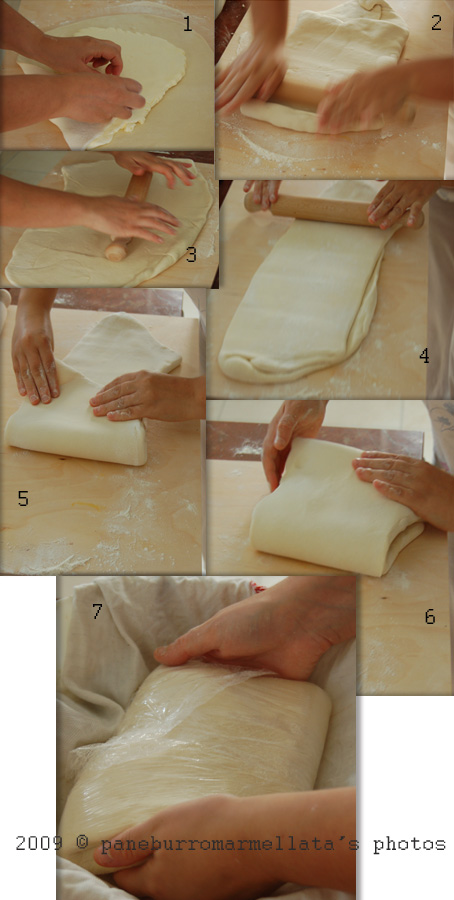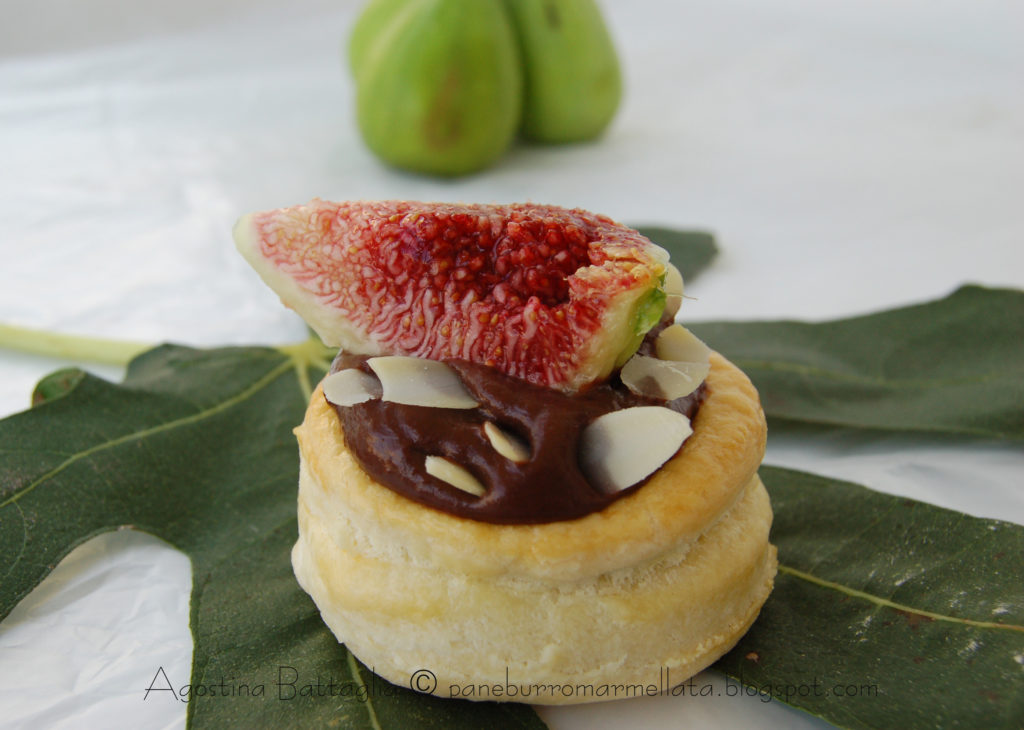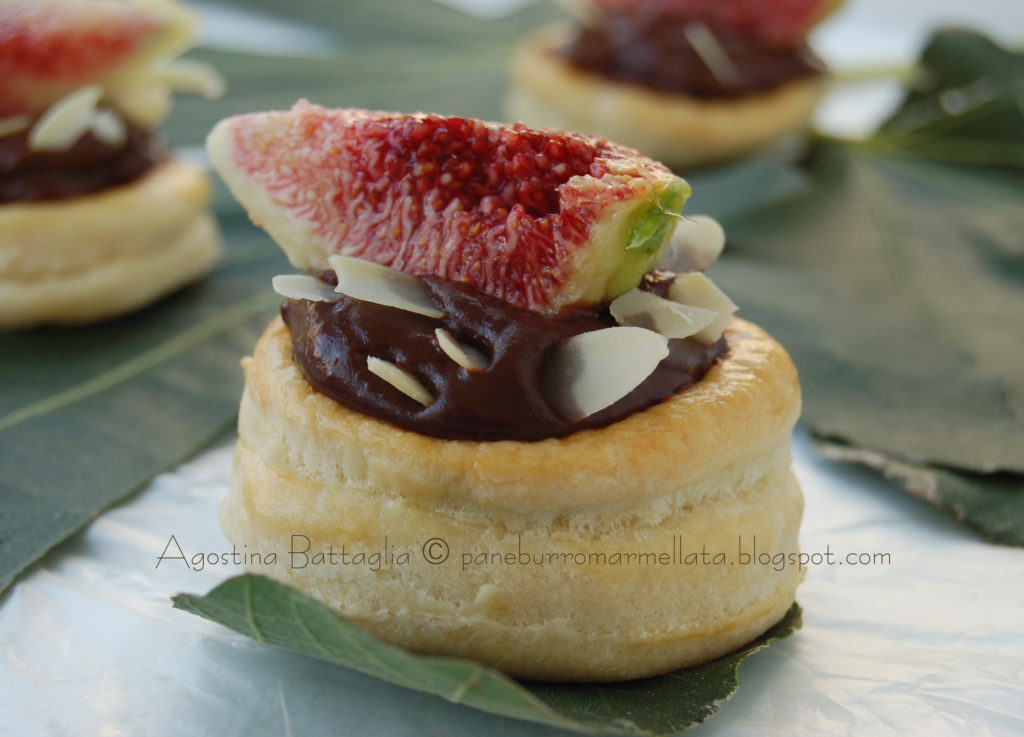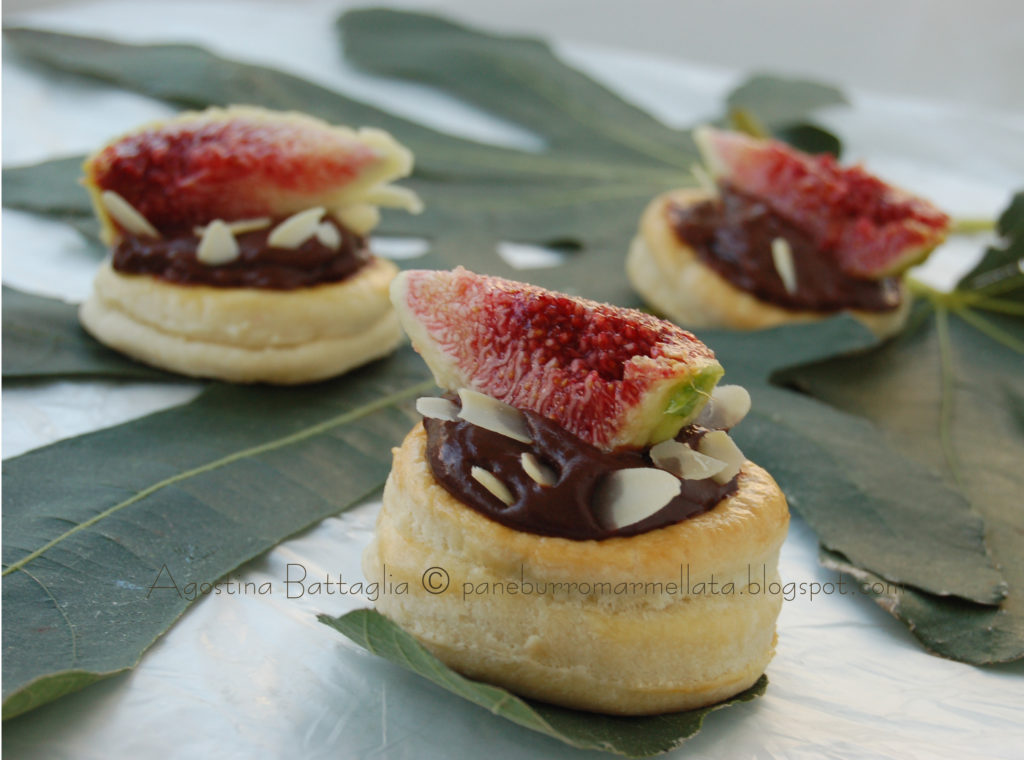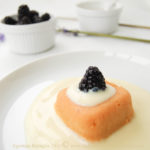Click here to read the English version
Ritornano i Daring bakers finalmente! Il mese scorso non ho potuto partecipare alla sfida, ma questo mese non potevo assolutamente mancare…perchè?
Perchè è stata una sfida con i fiocchi, più semplice di quel che sembrava, ma impegnativa comunque.
la padrona di casa di questo mese è stata Steph di a whisk and a spoon….ed ha scelto di fare i vols au vent…facile, direte voi 😀
Eee no, non proprio così semplice, dato che la pasta sfoglia doveva essere fatta in casa, quindi niente di già pronto 😉
La ricetta che ha scelto per farla, proviene dal libro Baking with Julia (il libro tratta delle ricette che Julia Child sperimenta nel programma “Baking with Julia”, appunto) ed è di Michel Richard che ha spiegato il procedimento in un modo così semplice che sembrava una barzelletta eseguirlo…ed infatti così è stato!
Diciamo che la vera sfida è stata proprio questa.
Sinceramente, era da parecchio che volevo cimentarmi nella produzione della pasta sfoglia casalinga, ma tra i vari timori del caso ed i dubbi sulla validità o meno delle ricette in circolazione, non mi sono mai decisa a farla…
La pasta sfoglia non è difficile da fare, anzi, come ho già detto, se si segue il procedimento esatto, è davvero semplice ottenerla: non so se dalle foto riuscite a cogliere la fragranza e la bontà del prodotto finito, ma vi posso assicurare che non ha niente a che vedere con la classica pasta che trovate al supermercato!
Innanzitutto, qui si usa solo burro al 100% e nemmeno in quantità esagerate; il prodotto finito non sa di burro, non unge e non appesantisce. Ne sono rimasta entusiasta e la rifarò prestissimo…pensavo di congelarla già spianata ed arrotolata in un foglio di carta forno, in modo da averla già pronta per l’uso …vedremo!
Se vi posso dare un consiglio: pro-va-te-la!!!!
Vi piacerà immensamente!!!
ricetta di Michel Richard
tratta dal libro Baking with Julia di Dorie Greenspan
Ingredienti:
- 500 g di farina
- 2 cucchiaini di sale
- 300 ml di acqua ghiacciata
- 450 g di burro molto freddo
Prepariamo la pasta:
Miscelare insieme la farina, il sale. Aggiungere l’acqua tutta in una volta fino a formare una palla. L’impasto sarà molto umido e sensibile, simile alla plastilina.
Avvolgere l’impasto in un asciugamano umido e riporre in frigorifero per circa 5 minuti.
Nel frattempo, porre il burro tra 2 fogli di pellicola trasparente ed appiattirlo con il mattarello in un quadrato dello spessore di un centimetro. fai attenzione che il burro rimanga freddo e fermo: se diviene soffice od olioso, raffreddalo bene prima di continuare.
Incorporando il burro:
Scartare l’impasto e collocarlo su una superficie infarinata (il marmo freddo è la superficie ideale per la pasta sfoglia). con il mattarello, spianare la pasta in un quadrato.
Mettere il burro nel centro e piegare gli angoli sul burro(foto n.1), fino a racchiuderlo completamente.
Per ottenere una fantastica pasta sfoglia, è necessario raffreddare l’impasto ogni volta. Sono indicati specifici momenti per raffreddare l’impasto, ma se la stanza è calda, o si lavora lentamente, oppure il burro inizia ad uscire inspiegabilmente dall’impasto, coprire la pasta con pellicola trasparente e passarlo in frigorifero per 30 minuti.
Questa operazione si può fare ogni qualvolta lo si ritenga opportuno.
Facendo i giri:
Delicatamente, ma in maniera ferma, pressa il mattarello sui ordi inferiori e superiori del quadrato. Quindi, mantenendo la superficie della pasta infarinata, stendere la pasta in un rettangolo tre volte più grande del quadrato di partenza (foto n.2).
Con questa operazione, il burro deve essere tirato in maniera uniforme all’interno di tutta la pasta (foto n.3)
A questo punto, piegare il rettangolo dal basso verso il centro e dall’alto verso il centro, come una lettera commerciale (per farvi capire meglio: dovete prendere il bordo inferiore della pasta spianata che si trova davanti a voi e portarlo al centro, stessa cosa con il bordo superiore, che andrà a sovrapporsi al bordo inferiore che si trova già al centro), *spianarlo verso destra e verso sinistra fino ad ottenere una striscia (foto n.4).
Piegare la parte sinistra verso il centro (foto n.5)e stessa cosa con la parte destra, che si andrà a sovrapporre alla sinistra – dovremmo ottenere un pacchetto – (foto n.6)
In questo modo si è completato un giro*.
Ruotare la pasta in modo che la chiusura sia verso sinistra. Ripetere il processo indicato sopra da * a * e così abbiamo il secondo giro.
Raffreddando la pasta:
Se la pasta è ancora fredda ed il burro non è fuoriuscito, si possono effettuare altri 2 giri, altrimenti è meglio avvolgerlo in un foglio di pellicola trasparente e farlo refrigerare per almeno 30 minuti.
E’ meglio refrigerare la pasta da 30 a 60 minuti ogni set di 2 giri, avvolgendo sempre la pasta in pellicola trasparente (foto n.7), prima di essere riposta in frigo.
Il numero totale di giri necessari è 6. Se si preferisce, si possono effettuare 4 giri, far riposare l’impasto in frigo tutta la notte e dare gli ultimi 2 giri il giorno dopo.
La pasta sfoglia rende ottimamente se refrigerata bene, quindi il passaggio in frigo è importantissimo. Inoltre, deve essere molto fredda soprattutto nel momento in cui l’andiamo ad utilizzare…quanto più è fredda tanto più sfoglia e diviene alta.
La seconda parte della sfida, prevedeva l’utilizzo della pasta sfoglia ottenuta, facendo dei vols au vent, dolci e/o salati
Ho pensato di provarli in entrambe le versioni:
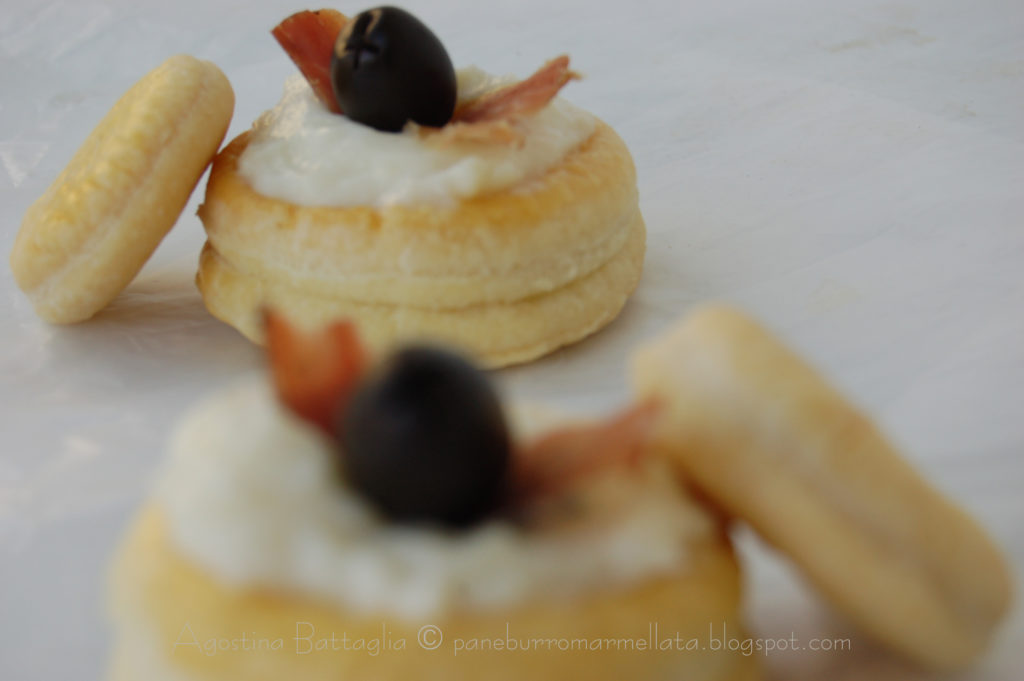
Per la versione salata, ho riempito i vols au vent di crema al parmigiano e decorati con una striscetta di pancetta affumicata ed un’oliva nera denocciolata.
La crema al parmigiano è semplicissima:
Ingredienti:
- 2 cucchiai di farina
- 250 gr di latte
- 100 gr di formaggio parmigiano grattuggiato
- sale
- noce moscata
Sciogliere, mescolando, la farina nel latte. Porre sul gas e far rapprendere – deve divenire densa. Togliere dal fuoco e versare il parmigiano. Far assemblare bene, sempre mescolando, grattuggiare pochissima noce moscata ed aggiustare di sale.
Per la versione dolce: ho riempito i vols au vent di crema al cioccolato senza uova e decorati con sfogliette di mandorle e fichi.
La crema al cioccolato light, si ottiene così:
Ingredienti:
- 60 gr di farina
- 2 – 3 cucchiai di cacao amaro (del tipo Von Hauten)
- 90 – 100 gr di zucchero
- 500 gr di latte
Scaldare il latte.
In un pentolino, miscelare zucchero, cacao e farina. Sempre mescolando, unire il latte tiepido e porre sul gas a fiamma bassa. Mescolare continuamente fino a che la crema non diviene densa.
Hi guys!!! 😀
I’m so sorry to be so late with my post, but I’m on holidayyyy since the past week!
However, better late than never, right? 😉
So, this was a great challenge: I loved my first attempt at Puff Pastry, It’s easier than I thought and I was so happy to do it…This recipe is exquisite – not oily or fat…the perfect puff pastry and, above all, I love its taste…so delicate! ;-999
Surely I will make more of this in the future!
The September 2009 Daring Bakers’ challenge was hosted by Steph of A Whisk and a Spoon. She chose the French treat, Vols-au-Vent based on the Puff Pastry recipe by Michel Richard from the cookbook Baking With Julia by Dorie Greenspan.
Ok, let’s start with the Puff pastry recipe:
Michel Richard’s Puff Pastry Dough
From: Baking with Julia by Dorie Greenspan
Yield: 2-1/2 pounds dough
Ingredients:
- 2-1/2 cups (12.2 oz/ 354 g) unbleached all-purpose flour
- 1-1/4 cups (5.0 oz/ 142 g) cake flour
- 1 tbsp. salt (you can cut this by half for a less salty dough or for sweet preparations)
- 1-1/4 cups (10 fl oz/ 300 ml) ice water
- 1 pound (16 oz/ 454 g) very cold unsalted butter
plus extra flour for dusting work surface
Mixing the Dough:
Check the capacity of your food processor before you start. If it cannot hold the full quantity of ingredients, make the dough into two batches and combine them.
Put the all-purpose flour, cake flour, and salt in the work bowl of a food processor fitted with a metal blade and pulse a couple of times just to mix. Add the water all at once, pulsing until the dough forms a ball on the blade. The dough will be very moist and pliable and will hold together when squeezed between your fingers. (Actually, it will feel like Play-Doh.)
Remove the dough from the machine, form it into a ball, with a small sharp knife, slash the top in a tic-tac-toe pattern. Wrap the dough in a damp towel and refrigerate for about 5 minutes.
Meanwhile, place the butter between 2 sheets of plastic wrap and beat it with a rolling pin until it flattens into a square that’s about 1″ thick. Take care that the butter remains cool and firm: if it has softened or become oily, chill it before continuing.
Incorporating the Butter:
Unwrap the dough and place it on a work surface dusted with all-purpose flour (A cool piece of marble is the ideal surface for puff pastry) with your rolling pin (preferably a French rolling pin without handles), press on the dough to flatten it and then roll it into a 10″ square. Keep the top and bottom of the dough well floured to prevent sticking and lift the dough and move it around frequently. Starting from the center of the square, roll out over each corner to create a thick center pad with “ears,” or flaps.
Place the cold butter in the middle of the dough and fold the ears over the butter, stretching them as needed so that they overlap slightly and encase the butter completely. (If you have to stretch the dough, stretch it from all over; don’t just pull the ends) you should now have a package that is 8″ square.
To make great puff pastry, it is important to keep the dough cold at all times. There are specified times for chilling the dough, but if your room is warm, or you work slowly, or you find that for no particular reason the butter starts to ooze out of the pastry, cover the dough with plastic wrap and refrigerate it . You can stop at any point in the process and continue at your convenience or when the dough is properly chilled.
Making the Turns:
Gently but firmly press the rolling pin against the top and bottom edges of the square (this will help keep it square). Then, keeping the work surface and the top of the dough well floured to prevent sticking, roll the dough into a rectangle that is three times as long as the square you started with, about 24″ (don’t worry about the width of the rectangle: if you get the 24″, everything else will work itself out.) With this first roll, it is particularly important that the butter be rolled evenly along the length and width of the rectangle; check when you start rolling that the butter is moving along well, and roll a bit harder or more evenly, if necessary, to get a smooth, even dough-butter sandwich (use your arm-strength!).
With a pastry brush, brush off the excess flour from the top of the dough, and fold the rectangle up from the bottom and down from the top in thirds, like a business letter, brushing off the excess flour. You have completed one turn.
Rotate the dough so that the closed fold is to your left, like the spine of a book. Repeat the rolling and folding process, rolling the dough to a length of 24″ and then folding it in thirds. This is the second turn.
Chilling the Dough:
If the dough is still cool and no butter is oozing out, you can give the dough another two turns now. If the condition of the dough is iffy, wrap it in plastic wrap and refrigerate it for at least 30 minutes. Each time you refrigerate the dough, mark the number of turns you’ve completed by indenting the dough with your fingertips. It is best to refrigerate the dough for 30 to 60 minutes between each set of two turns.
The total number of turns needed is six. If you prefer, you can give the dough just four turns now, chill it overnight, and do the last two turns the next day. Puff pastry is extremely flexible in this regard. However, no matter how you arrange your schedule, you should plan to chill the dough for at least an hour before cutting or shaping it.
About the second part of this amusing challenge, the Vols au vent, I made two fillings:
one, a savoury vol au vent with parmesan cream and decorated with bacon and pitted oils
Parmesan cream is simple:
Ingredients:
- 2 tbsp of flour
- 250 grams of milk
- 100 grams of grated parmesan cheese
- salt
- Nutmeg
Dissolve flour in milk. Put on gas and thicken it, mixing constantly. Remove from heat and pour the Parmesan. Assemble stirring well, and put on it a little bit of grated nutmeg and salt.
and the other one, a sweet vol au vent with a light chocolate cream and decorated with slivered almonds and figs.
The light chocolate cream
Ingredients:
- 60 g flour
- 2 – 3 tbsp of unsweetened cocoa (like Von Hauten)
- 90 – 100 gr sugar
- 500 grams of milk
Heat the milk.
In a saucepan, mix sugar, cocoa and flour. Still stirring, add the warm milk and put on gas (flame low). Stir continuously until that the cream becomes thick.

